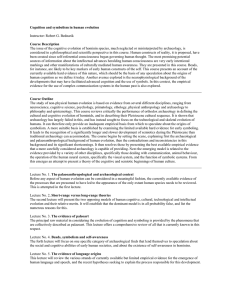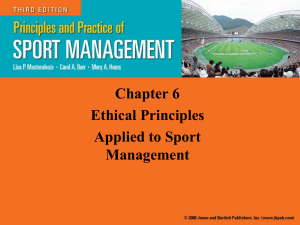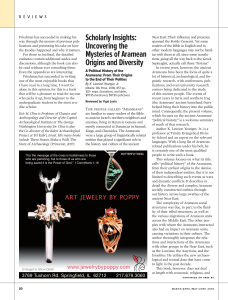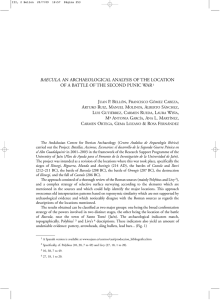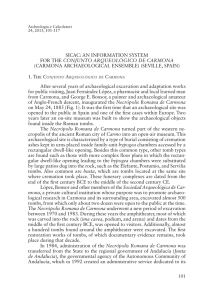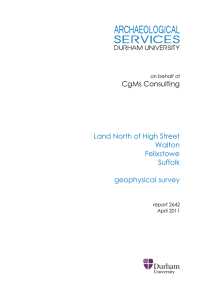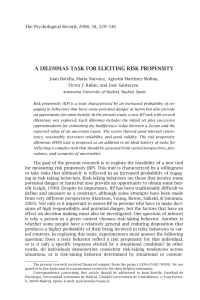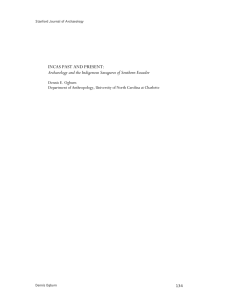Ethic issues about excavations in churches and cementeries
Anuncio
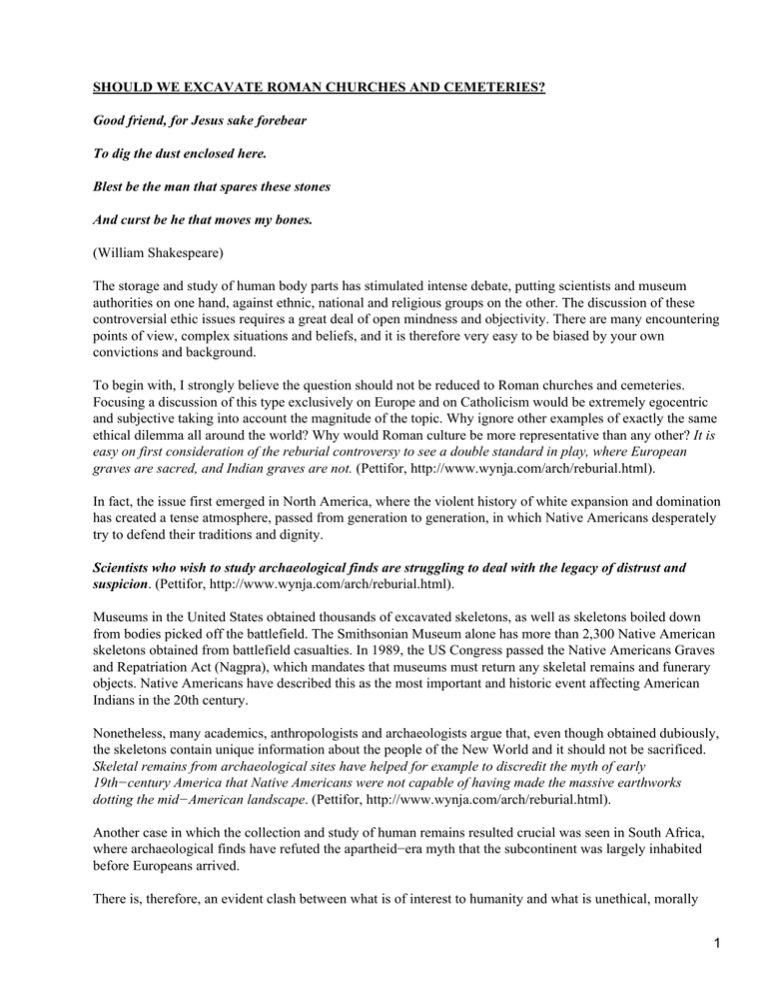
SHOULD WE EXCAVATE ROMAN CHURCHES AND CEMETERIES? Good friend, for Jesus sake forebear To dig the dust enclosed here. Blest be the man that spares these stones And curst be he that moves my bones. (William Shakespeare) The storage and study of human body parts has stimulated intense debate, putting scientists and museum authorities on one hand, against ethnic, national and religious groups on the other. The discussion of these controversial ethic issues requires a great deal of open mindness and objectivity. There are many encountering points of view, complex situations and beliefs, and it is therefore very easy to be biased by your own convictions and background. To begin with, I strongly believe the question should not be reduced to Roman churches and cemeteries. Focusing a discussion of this type exclusively on Europe and on Catholicism would be extremely egocentric and subjective taking into account the magnitude of the topic. Why ignore other examples of exactly the same ethical dilemma all around the world? Why would Roman culture be more representative than any other? It is easy on first consideration of the reburial controversy to see a double standard in play, where European graves are sacred, and Indian graves are not. (Pettifor, http://www.wynja.com/arch/reburial.html). In fact, the issue first emerged in North America, where the violent history of white expansion and domination has created a tense atmosphere, passed from generation to generation, in which Native Americans desperately try to defend their traditions and dignity. Scientists who wish to study archaeological finds are struggling to deal with the legacy of distrust and suspicion. (Pettifor, http://www.wynja.com/arch/reburial.html). Museums in the United States obtained thousands of excavated skeletons, as well as skeletons boiled down from bodies picked off the battlefield. The Smithsonian Museum alone has more than 2,300 Native American skeletons obtained from battlefield casualties. In 1989, the US Congress passed the Native Americans Graves and Repatriation Act (Nagpra), which mandates that museums must return any skeletal remains and funerary objects. Native Americans have described this as the most important and historic event affecting American Indians in the 20th century. Nonetheless, many academics, anthropologists and archaeologists argue that, even though obtained dubiously, the skeletons contain unique information about the people of the New World and it should not be sacrificed. Skeletal remains from archaeological sites have helped for example to discredit the myth of early 19th−century America that Native Americans were not capable of having made the massive earthworks dotting the mid−American landscape. (Pettifor, http://www.wynja.com/arch/reburial.html). Another case in which the collection and study of human remains resulted crucial was seen in South Africa, where archaeological finds have refuted the apartheid−era myth that the subcontinent was largely inhabited before Europeans arrived. There is, therefore, an evident clash between what is of interest to humanity and what is unethical, morally 1 incorrect and unnecessary. Who decides? Where has the boundary been drawn between these two? Is it the religion the burial belongs to? Is it time what makes the difference? Is it the fact the deceased belonged to an unknown or exotic culture? Last year, Israel's attorney general handed down a new interpretation of the 1978 Antiquities Act which only gives scientists the right to study human−made objects, but not the makers of these objects. As a result, all human remains younger than 5,000 years have been cleared from the shelves of the Antiquities Authority, and the older ones are seriously threatened. (Pettifor, http://www.wynja.com/arch/reburial.html). Was this a viable solution? Is it actually reasonable to measure if it is ethic or not to display corpses just by the amount of time they have been dead? In Western thought, primitive is a temporal concept that creates otherness by relegating people to an ancient time, regardless of their true historical context. (Fabian, quoted in McGuirre, 1989). Let's consider for a moment the extreme case of Neanderthals. These hominids thrived in Europe from 200,000 to 27,000 years ago. Neanderthal skeletons are often remarkably complete, and there is plenty of evidence to suggest burial−− the degree of preservation, the consistently flexed position as well as deliberately dug graves at several sites such as La Chapelle aux Saints, (a rectangular burial pit), or La Ferrasie, (six burials, one of them covered with a triangular stone slab). In addition, tools or animal parts were deliberately deposited as grave goods or for symbolic ritual in some cases. Considering this evidence, it is difficult to accept that burials of these characteristics were mere hygienic practices. There must have been some religion or belief of some sort behind this behaviour as far back as 200,000 years ago. Whether basic or complex, ancient or contemporary, is it ethical for us to decide what beliefs deserve being respected? Is time an efficient measuring stick after all? We must remember that the person who died yesterday was just as human as the mummy of Ramses II, for example, dead more than 3,000 years ago and exposed in this precise moment behind a thick security panel in El Cairo Museum. If time therefore is not such an efficient way of creating a clearer differentiation between the lack of respect and the necessary archaeological research, what could we use as a reference? One of the most practical methods for the archaeologist is simply taking into account if the deceased is claimed by someone. The louder someone seems to shout against the disturbance of a certain burial, the more unethical it appears to become. This introduces us into another aspect of ethics and archaeology. By looking at several cases, one will soon discover that there is a tremendous amount of interests behind a dead person or group of people!−− nationalism, social status, economic benefits and so on. The sacredness of graves is provisional and of limited duration, typically the lifetime of the immediate descendants of the diseased, providing they are concerned for the preservation of the grave. Sometimes even if they are concerned it is of no consequence if they are in the lower socio−economic class and do not have the resources to assert their interest. There are many factors that come into play. (Eric Pettifor, http://www.wynja.com/arc/reburial.html). In other cases, one can discover such ridiculous situations as Native Americans claming museum materials 5,000 years old with nationalistic purposes, ignoring in reality if they are venerating the bones of alien groups and traditional enemies rather than distant relatives! Should archaeologists and physical anthropologists feel free to investigate and collect corpses taking advantage of the fact that nobody wants to claim them (or has the power to claim them)? Should society listen to the fanatic and interested sensationalistic cries of some who try to make profit of the dead, inventing dubious connections with the past and creating incompatible analogies with the present? From the ethical perspective things do not seem immediately clear. If ethics are relative, then the ethics of archaeology are at odds with the ethics of religious and nationalistic groups. Will the `correct' ethics be ever 2 defined? Is there actually such a thing as a `correct' ethics? The discussion of these thoughts would bring us all the way back to Greek classical philosophy and the concept of good vs. bad. Nonetheless, I will fortunately not have to quote Plato and Epictetus in my essay, since this reflection has already been taken by the Social Science Federation of Canada, (SSFC), and is outlined in their publication Ethical Decision Making for Practical Social Scientists−− a) Dilemmas may result from conflict between the interests of different parties... Can all interests be served, or must priorities be set and choices be made? b) Dilemmas may arise from conflict between principles... c) Dilemmas may arise from the sheer complexity of competing parties and pressure. d) Dilemmas may arise from lack of awareness of the probable consequences of some behaviour, or lack of foresight, or lack of knowledge of ethical principles. (Cannie Stark−Adamec and Jean Pettifor, 1995). As an answer to all these `dilemmas,' the SSFC proposes a series of steps that will hopefully help to solve the problem−− 1) Identify the ethically−relevant issues, principles, standards, rules and practices. 2) Identify the different parties affected by your decision and their special characteristics and interests. 3) Develop all the alternative courses of actions. 4) Analyse the likely short−term, ongoing, and long term risks, benefits, consequences of each course of action on different persons who may be affected by your decisions. 5) Consider how any personal values, biases, beliefs, or self−interest may influence your decision−− either positively or negatively. [...] (Cannie Stark−Adamec and Jean Pettifor, 1995). It is this type of associations and organisations such as the SSFC what I see as the most viable solution to the ethical problem in archaeology. Considering all the situations, interests and different points of view surrounding this complex issue, my answer to should we excavate churches and cemeteries is yes. Yes, but only under the control of special archaeological organisations−− organisations working not even at a national scale, but for specific provinces, counties or regions. These organisations should consider the individual situation of their allocated region and produce a well defined concept of what bears archaeological interest in their area and which sites should not be disturbed, based on the amount of information the material is capable of producing, on public enquiries and on ethical aspects such as the history of the region and the type of population. A similar organ in England would be the English Heritage−− a statutory body set up by Parliament to advise the Secretary of State for National Heritage on archaeological matters including the selection of buildings and sites for listing or scheduling. It also channels funding for excavation and publication and draws up advisory documents such as PPG16. English Heritage monitors the state of scheduled sites and listed buildings and directly runs and manages a few of the more important sites such as Stonehenge and the Tower of London. At a more regional scale, SCOLA, (the Standing Conference on London Archaeology), is a body founded by LAMAS, Surrey Archaeological Society, the Society of Antiquaries and the Council for British Archaeology and is intended to monitor archaeological work in London and ensure that standards are maintained. 3 Evaluation and responsibility are ongoing. Co−operation towards a deeper understanding of the culture is what we should seek. The situation cannot be resolved, but it will evolve, and the best case scenario is one in which we harvest and share the fruits of both perspectives. The return of the bones of the ancestors seems to us to violate what we consider an ethical obligation not only to the people of prehistory, but to living people today, as well as to future generations. Destruction of data is analogous to the burning of libraries. (Goldstein and Kintigh, 1990). BIBLIOGRAPHY • Bobillot, Pierre, La Momie de Ramses II, Paris, Recherche sur les Civilisations, 1985. • Houlbrooke, Ralph, Death, Ritual and Bereavement, London, New York, Routledge, 1989. • McGuirre, Randall H. The Sanctity of the Grave, London, Unwin Hyman, 1989. • Roux, Jean−Paul, La Mort Chez les Peuples Altaiques Anciens et Medievaux, Paris, Librairie d'Amerique et d'Orient, 1963. • Thomas, Julian, Time, Culture and Identity, London, New York, Routledge, 1996. • http://www.mg.co.za./mg/news/9feb/2feb−oldbones3.html, Who Owns the Dead? Science or the Descendants? Professor Andrew Sillen. • http://www.wynja.com/arc/reburial.html, The Reburial Controversy, Eric Pettifor. • http://www.cpu.lu./gka/rites.htm, Funeral Rituals. 4

